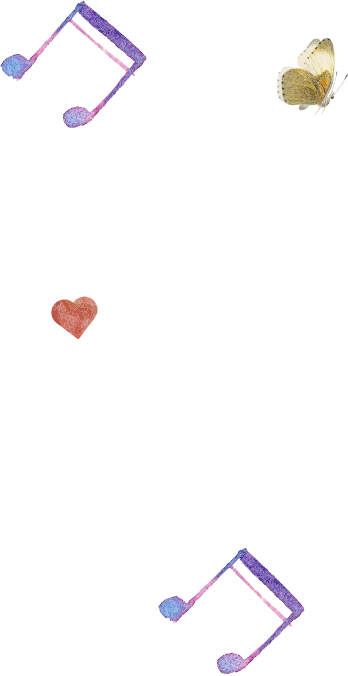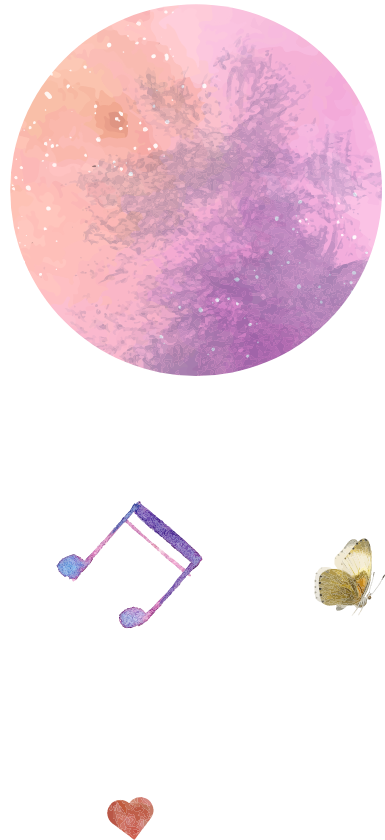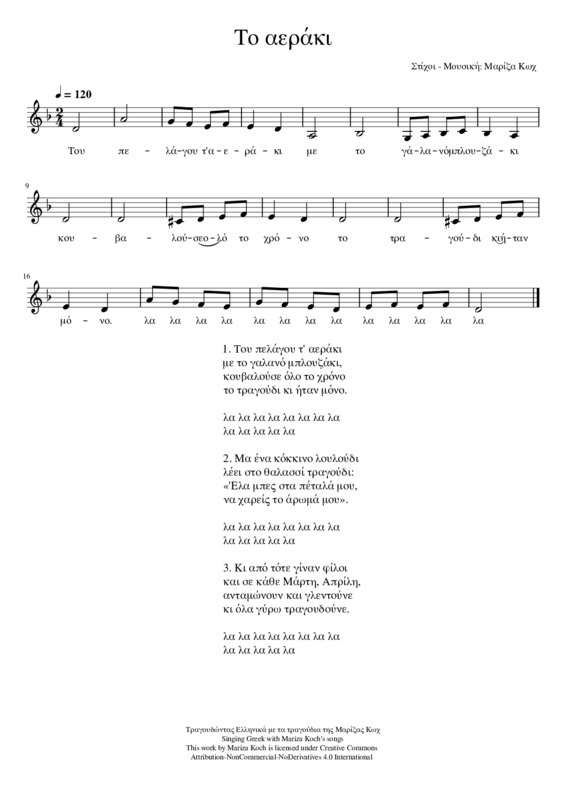
To aeraki

To aeraki
Pronunciation
Articulation of the phoneme /ρ/ (r) and its use in the Greek language [αεράκι (aeraki, breeze), χρόνο (chrono, time), άρωμα (arōma, perfume), τραγούδι (tragoudi, song), Μάρτη (Martē, March), Απρίλη (Aprilē, April), etc.]
Speech Comprehension and Production
Recognize the cross rhyme of the song [αεράκι (aeraki, breeze), μπλουζάκι (blouzaki, t-shirt)/ χρόνο (chrono, time), μόνο (mono, only)/ λουλούδι (louloudi, flower), τραγούδι μου (tragoudi mou, my song)/ πέταλά μου (petala mou, my petals), άρωμά μου (arōma mou, my perfume), φίλοι (philoi, friends), Απρίλη (Aprilē, April)]. Practice finding rhyming words.
Personification and metaphor: the breeze wore a T-shirt and carried a song, the flower speaks to the song, the flower and the song became friends.
Adjectives that identify colors: blue, red, sea blue (the color of the sea).
Discussion on the value of companionship through the content of the song: e.g. the breeze was alone in the first verse, in contrast with the last verse where everyone has become friends, parties and sings.
The pupils are asked to find the poetic elements of the song. Then they create their own poem in small groups where different elements of nature get together.
Personification and metaphor: the breeze wore a T-shirt and carried a song, the flower speaks to the song, the flower and the song became friends.
Adjectives that identify colors: blue, red, sea blue (the color of the sea).
Discussion on the value of companionship through the content of the song: e.g. the breeze was alone in the first verse, in contrast with the last verse where everyone has become friends, parties and sings.
The pupils are asked to find the poetic elements of the song. Then they create their own poem in small groups where different elements of nature get together.
Music Activities
Practice the song using harmonious accompaniment. Use the melodic pattern λα-λα-λα (la-la-la) as a melodic ostinato that will accompany the whole song. Perform the song as a two-part canon (introduction of the second group after four bars).
Breathing exercises with the element of air blowing gently and loudly. Create a sound story based on the content of the song: a lonely breeze travels with a song, meets a flower and they become friends, and every spring they party and sing.
Render the air with the movements of the body: the pupils are divided into two groups, the first group physically depicts the intensity and the direction of the wind, while the second group creates a sound image with Orff instruments based on the movement of the first group (a conductor game).
Musical and movement activities where the class is divided into two groups: one group imitates the song and the other group imitates the flower, in order to explore the escalation of emotion from melancholy to happiness and companionship (colored handkerchiefs, ribbons or other objects can be used ).
Breathing exercises with the element of air blowing gently and loudly. Create a sound story based on the content of the song: a lonely breeze travels with a song, meets a flower and they become friends, and every spring they party and sing.
Render the air with the movements of the body: the pupils are divided into two groups, the first group physically depicts the intensity and the direction of the wind, while the second group creates a sound image with Orff instruments based on the movement of the first group (a conductor game).
Musical and movement activities where the class is divided into two groups: one group imitates the song and the other group imitates the flower, in order to explore the escalation of emotion from melancholy to happiness and companionship (colored handkerchiefs, ribbons or other objects can be used ).
Cross-thematic Connections - Greek Culture
Interdisciplinary concepts: evolution.
The pupils are asked to capture different moments of the song's story in paintings and to arrange them in order. Alternatively they can create group paintings with reference to friendship and companionship, as described in the song.
Refer to the compass rose. Discussion on how wind affects human life (navigation, air transport, wind energy, etc.) and talk about the changes of wind intensity.
Improvised dialogues for human communication: from simple acquaintance to the expression of friendship, trust and companionship.
Reference to the basic and complementary colors, and the color scale. Examples from various works of art. Artistic experiments with close shades in the color palette.
The pupils are asked to capture different moments of the song's story in paintings and to arrange them in order. Alternatively they can create group paintings with reference to friendship and companionship, as described in the song.
Refer to the compass rose. Discussion on how wind affects human life (navigation, air transport, wind energy, etc.) and talk about the changes of wind intensity.
Improvised dialogues for human communication: from simple acquaintance to the expression of friendship, trust and companionship.
Reference to the basic and complementary colors, and the color scale. Examples from various works of art. Artistic experiments with close shades in the color palette.
Age level
3-7 years old
Language level
Beginner
Seasons
Ta tragoudia pane theatro





